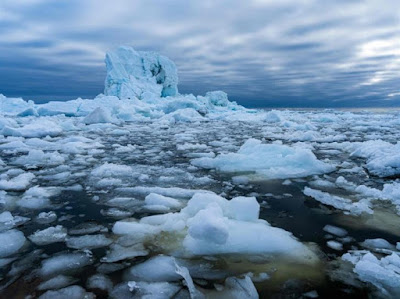Filenews 8 August 2021
Climatologists have identified warning signs that indicate a significant likelihood of the collapse of the Gulf Stream, one of the most critical turning points on the planet.
The survey found "an almost complete loss of stability over the last century" of currents called meridian Atlantic Traffic Rollover (AMOC). Currents have already reached their slowest record in at least 1,600 years, but new analysis suggests they may be approaching complete collapse.
Such an event would have disastrous consequences for the entire planet, significantly disrupting the rains on which the food of billions of people in India, South America and West Africa depends. In addition, it would lead to an increase in storms and a decrease in temperatures in Europe and sea level rise in eastern South America. It would also increase the risk to the Amazon rainforest, as well as the Antarctic glaciers.
The AMOC system is extremely complex, which combined with uncertainty about the levels of future global warming makes it impossible to predict the date of collapse. It could happen within a decade or two or after several centuries. However, the colossal impact it will have if and when it happens means that we will have to prevent it at all costs, scientists warn.
"The fact that the signs of destabilisation are already visible is something I didn't expect to see and which I find frightening," Niklas Boers, of the Potsdam Institute for Climate Impact Research in Germany, which carried out the research, told the Guardian. "It's something we just can't let happen."
We do not yet know what levels of carbon dioxide could trigger the collapse of the AMOC, he added. "So the only thing we can do is limit emissions as much as possible. The likelihood of having this evolution with the extreme effects increases with every gram of carbon dioxide we emit into the atmosphere."
Scientists are increasingly concerned about turning points – that is, large, rapid and irreversible climate changes. Boers and his colleagues said in May that a significant part of Greenland's glacier is on the brink of disaster, threatening a major rise in global sea levels. Other research has recently shown that the Amazon rainforest now emits more carbon dioxide than it absorbs, but also that the 2020 heat wave in Siberia has led to the release of alarming amounts of methane.
The planet may have already overcome a number of turning points, according to a 2019 analysis, which overall make up an "existential threat to human civilization." A major report by the Intergovernmental Panel on Climate Change, to be published on Monday, is expected to highlight the deteriorating state of climate change.
Boer's research, published in the scientific journal Nature Climate Change, is titled "Early warning signs of possible AMC collapse based on observation." Ice cores and other data from the last 100,000 years show that the AMOC is characterized by two states: in the first and strong, prevailing over the last millennia, and a second, weak state. The data show that warming can cause the AMOC to shift sharply between the two states within one to five decades.
The circulation of the AMOC depends on the dense seawater submerged in the Arctic Ocean, but the fresh water poured into the sea by the melting of Greenland's ice slows this process sooner than previous climate models showed.
Boers used the analogy of a chair to explain how changes in ocean temperature and salinity can reveal the instability of the AMOC. When we push a chair we change its position, but this does not affect its stability if all its legs remain on the floor. But if we push it by tilting it, it affects both its position and its stability.
Eight databases of temperature and salinity that have emerged from independent measurements over a depth of 150 years have allowed Boers to show that global warming actually exacerbates the instability of currents, and does not simply change the pattern of their flow.
The analysis concludes:
"This degradation [of the AMOC over the last few decades] may be linked to the near-complete loss of stability over the last century, resulting in the AMOC being close to a critical shift towards its weak traffic situation."
Levke Caesar, of Maynooth University in Ireland, who was not involved in the study, told the Guardian: "The study methodology cannot give us the exact time of the possible collapse, but the analysis shows evidence that we may be closer to shifting the AMOC than we think."
David Thornali, of UCL University in Britain, whose work has shown that the AMOC is in the weakest state it has been in in 1,600 years, said:
"These signs of deteriorating stability are worrying. But we still don't know if there will be a collapse or how close we are to it."
